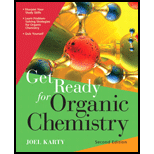
(a)
Interpretation:
The structure of diethylamine is to be drawn. The amine is to be identified as primary, secondary, or tertiary.
Concept introduction:
Trivial names of several
Depending on whether the number of alkyl groups attached to the nitrogen is one, two, or three, the amine is classified as primary, secondary, or tertiary amine.
(b)
Interpretation:
The structure of diethylpropylamine is to be drawn. The amine is to be identified as primary, secondary, or tertiary.
Concept introduction:
Trivial names of several amines are still in common use. The names of the trivial names of alkyl groups, attached to nitrogen in the amine, are written first, followed by the suffix amine.
Depending on whether the number of alkyl groups attached to the nitrogen is one, two, or three, the amine is classified as primary, secondary, or tertiary amine.
(c)
Interpretation:
The structure of allylmethylamine is to be drawn. The amine is to be identified as primary, secondary, or tertiary.
Concept introduction:
Trivial names of several amines are still in common use. The names of the trivial names of alkyl groups, attached to the nitrogen in the amine, are written first, followed by the suffix amine.
Depending on whether the number of alkyl groups attached to the nitrogen is one, two, or three, the amine is classified as primary, secondary, or tertiary amine.
(d)
Interpretation:
The structure of cyclopentylamine is to be drawn. The amine is to be identified as primary, secondary, or tertiary.
Concept introduction:
Trivial names of several amines are still in common use. The names of the trivial names of alkyl groups attached to the nitrogen in amine are written first, followed by the suffix amine.
Depending on whether the number of alkyl groups attached to the nitrogen is one, two, or three, the amine is classified as primary, secondary or tertiary amine.
(e)
Interpretation:
The structure of dibenzylamine is to be drawn. The alcohol is to be identified as primary, secondary, or tertiary.
Concept introduction:
Trivial names of several amines are still in common use. The names of the trivial names of alkyl groups attached to the nitrogen in the amine are written first, followed by the suffix amine.
Depending on whether the number of alkyl groups attached to the nitrogen is one, two or three, the amine is classified as primary, secondary or tertiary amine.
Want to see the full answer?
Check out a sample textbook solution
Chapter E Solutions
Get Ready for Organic Chemistry
- Which type of amine is phentermine? a) a primary aliphatic amine b) a primary aromatic amine c) a tertiary aliphatic amine d) a tertiary aromatic aminearrow_forwardThe structure of Amines are classified as primary (1), secondary (2), and tertiary (3) based on the number of R group like providing name the parent chain, name alkyl group substitutes, name of amine by placing the alkyl groups in alphabetical order and specifying their position, followed by the name of the parent chain that concept that seemed difficult to you at first, but then after working on the concept, you were able to master it. Include a description of what made the concept difficult at first, and then discuss what you did in order to better understand the concept.arrow_forwardName this amine properly. Is it a primary, secondary , or tertiary amine?arrow_forward
- 1) Which of the following is a tertiary amine? A) B) CH3 C) CH3 D) E) CH CH2₂NH2 CH 3 .. NCH3 CH 3 CH 3 CH 3 C CH3 1 NH-CH3 ... CHỖ CHCH CH3 CH3 NH2 CH 3 .. CH 3 C CH 3 1 NH₂arrow_forwardWhich of the following amines are derivatives of 2-phenylethylamine? Label the atoms of 2-phenylethylamine in those amines that contain this unit.arrow_forwardWhen amines are reacted with bases, they form ammonium salts. Is that true or false?arrow_forward
- Which compound is a primary amine with the formula C5H13N? * H2N H2N II III NH2 IV V IV O II O III and V d、飞arrow_forwardWrite the common name for each amine. HỌC—N—CH,CH3 H₂C-CH₂-CH₂-CH₂ Ethylbutylamine common name: Incorrect HC—CH,—N—CH,—CHy CH₂ CH3 diethylethylamine common name: Incorrect These compounds are tertiary amines.arrow_forwardA) Name the following amine. H3C−CH2−CH2−NH−CH2−CH2−CH3 Spell out the full name of the compound. B ) Name the following amine. CH3−CH2−NH−CH2−CH2−CH3 Spell out the full name of the compound.arrow_forward
- Explain why 3-methylbutylamine is a stronger base than the corresponding amide, 3-methylbutanamide, (CH3)2CHCH₂CONH₂.arrow_forward1. Classify each amines as primary, secondary, or tertiary, then provide the IUPAC name for each. Br NH2 Но NH2arrow_forwardDraw a structural formula for each amine. (a) 1,5-Pentanediamine (b) 2-Bromoaniline (c) Tributylaminearrow_forward
 ChemistryChemistryISBN:9781305957404Author:Steven S. Zumdahl, Susan A. Zumdahl, Donald J. DeCostePublisher:Cengage Learning
ChemistryChemistryISBN:9781305957404Author:Steven S. Zumdahl, Susan A. Zumdahl, Donald J. DeCostePublisher:Cengage Learning ChemistryChemistryISBN:9781259911156Author:Raymond Chang Dr., Jason Overby ProfessorPublisher:McGraw-Hill Education
ChemistryChemistryISBN:9781259911156Author:Raymond Chang Dr., Jason Overby ProfessorPublisher:McGraw-Hill Education Principles of Instrumental AnalysisChemistryISBN:9781305577213Author:Douglas A. Skoog, F. James Holler, Stanley R. CrouchPublisher:Cengage Learning
Principles of Instrumental AnalysisChemistryISBN:9781305577213Author:Douglas A. Skoog, F. James Holler, Stanley R. CrouchPublisher:Cengage Learning Organic ChemistryChemistryISBN:9780078021558Author:Janice Gorzynski Smith Dr.Publisher:McGraw-Hill Education
Organic ChemistryChemistryISBN:9780078021558Author:Janice Gorzynski Smith Dr.Publisher:McGraw-Hill Education Chemistry: Principles and ReactionsChemistryISBN:9781305079373Author:William L. Masterton, Cecile N. HurleyPublisher:Cengage Learning
Chemistry: Principles and ReactionsChemistryISBN:9781305079373Author:William L. Masterton, Cecile N. HurleyPublisher:Cengage Learning Elementary Principles of Chemical Processes, Bind...ChemistryISBN:9781118431221Author:Richard M. Felder, Ronald W. Rousseau, Lisa G. BullardPublisher:WILEY
Elementary Principles of Chemical Processes, Bind...ChemistryISBN:9781118431221Author:Richard M. Felder, Ronald W. Rousseau, Lisa G. BullardPublisher:WILEY





